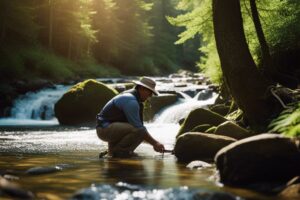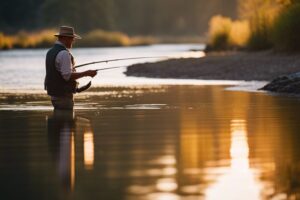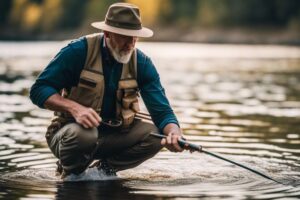Most anglers underestimate the charm and challenge of small streams, where dry fly fishing shines. Here, the delicate dance of a well-placed fly can entice wary fish lurking beneath the surface. You’ll learn the art of precision casting, the importance of stealth, and how to match your fly to the local hatch. This guide will help you navigate small waters with the confidence and skill needed to increase your chances of success. Get ready to connect with nature and the thrill of the catch in intimate fishing locales.
Choosing the Right Dry Fly
A dry fly can mean the difference between a successful outing and a frustrating day on the water. Selecting the right pattern is crucial when you’re casting in smaller streams. In these tight confines, the fish are often more discerning, and you need a fly that closely mimics the natural insects they’re feeding on. For comprehensive tips, check out The Ultimate Guide to Fly Fishing Small Streams.
Selecting Flies for Small Streams
Right from the start, choose flies that are appropriate for the water you plan to fish. Smaller streams often harbor a variety of insect life, but the size and type can change dramatically from one location to another. Consider using patterns like Elk Hair Caddis or Parachute Adams. These flies are versatile and float well, making them ideal for small water. It’s often more productive to select a few reliable patterns and master them than to overwhelm yourself with a wide array of options.
Considering Water Conditions and Insect Hatches
Selecting your fly also requires a keen awareness of the current water conditions and insect hatches. The time of day and the season greatly affect which insects are active, and consequently, which dry flies will be successful. Look for rising fish, as they are your best indicator of what they’re feeding on at that moment. The hatch may be related to weather conditions, so remain adaptable and responsive, adjusting your fly as needed as the day progresses.
Considering the constantly changing dynamics of small streams means you’ll need to be observant. If you notice a specific insect landing on the water’s surface or a consistent rise from the fish, adjust your fly choice accordingly. Pay attention to the size, color, and behavior of the local insects. Understanding the natural flow of your chosen stream will help you become a more effective angler and increase your chances of hooking a few fish.
Reading the Water
Assuming you want to maximize your success with dry fly fishing in small streams, understanding how to read the water is critical. This involves not only observing the surface activity of fish but also recognizing the nuances of the environment around your fishing target. The current, structure, and holding spots all play important roles in where fish are likely to be located. By honing your skills in reading the water, you equip yourself with the ability to make informed choices about where to place your fly.
Identifying Likely Holding Spots
One of the first things to look for in a small stream is the variation in the water’s depth and flow. Fish tend to seek out areas where they can rest while waiting for food to come to them. Look for spots like undercuts, fallen logs, or boulders that create eddies. These areas provide shelter and ambush points. Position your dry fly near these structures, and you may find fish ready to take your offering. It’s important to approach these spots quietly; a sudden splash or noise can send them scurrying.
Understanding Current and Structure
Water movement plays a significant role in fish behavior. Water that flows slower often holds more fish, especially during warmer months. You’ll want to pay attention to the seams where fast and slow currents meet; these areas can be prime feeding spots. The structure in the water not only offers cover for fish but can also change how the current flows, creating predictably favorable spots for casting your dry flies.
It’s also important to factor in how this moving water interacts with the shorelines and structures. Rippled areas and shaded pockets can work as natural hiding places for fish. By studying how currents create pockets of calm water, you can refine your approach and select the right flies to match the conditions. Look for feeding lanes and remember to adjust your casting techniques accordingly to maintain a natural float of your dry fly.
Presentation and Casting
It is important to master your casting technique when fly fishing in small streams. Your success depends on precision; even the smallest inaccuracies can spook fish or cause your fly to drift unnaturally. In these narrow environments, you won’t have the luxury of long casts. Instead, you will need to rely on short, accurate presentations that land your fly quietly on the water’s surface. Every cast must count. Aim for the shadows, the bubbles, and the edges where fish might be waiting. Be mindful that the more you practice accurate casting, the more natural it will feel, allowing you to focus on reading the water instead of your technique.
The Importance of Accurate Casting
Casting accurately in small streams is more than just a skill; it’s an art. Your fly must land delicately, mimicking the natural movement of insects. This is particularly vital in shallow water, where fish can be cautious. Each miscalculated cast could send the fish diving for cover. The goal is to make your presentation as subtle as possible. Utilize overhead casts or roll casts, depending on your surroundings, and keep your movements concise. Bear in mind, a well-placed fly combined with perfect timing can be the difference between a strike and a missed opportunity.
Mending and Controlling Drift
Drift is another crucial element when using dry flies. A proper drift mimics the natural rise and fall of insects on the water’s surface, and controlling it will enhance your chances of a catch. As your fly floats downstream, it can quickly become affected by current variations, which may drag it unnaturally across the water. This is where mending techniques come into play. With a simple flick of your wrist or an adjustment of your line, you can reposition the line to keep your fly in its proper place and encourage a more natural presentation.
Another reason to focus on mending is that it allows you to keep the fly in the strike zone longer, extending the opportunity for a fish to respond. By actively managing the line through mending, you create a sense of realism that entices fish to investigate your offering. Pay attention to the speed of the current and the position of your fly, making quick adjustments as necessary. This skill, combined with accurate casting, will elevate your dry fly fishing experience in small streams, bringing you closer to success on the water.
Fishing Techniques
Keep in mind that your approach to fishing small streams can significantly influence your success. The subtle nuances of dry fly fishing necessitate an understanding of various techniques. Each method has its unique advantages, and selecting the right one depends on the water conditions and the behavior of the fish. Familiarizing yourself with these techniques will help you adapt to the ever-changing environment of smaller water bodies.
Dead Drifting vs. Active Presentation
One of the most imperative concepts in dry fly fishing is the difference between dead drifting and active presentation. Dead drifting is about allowing your fly to float naturally with the current, mimicking the behavior of a real insect. This technique works best when fish are feeding on the surface, as the fly drifts alongside naturally occurring food. Ensure that your line is properly mended to avoid any unnatural drag that could spook wary fish.
In contrast, active presentation involves more deliberate movements and manipulations of the fly to entice fish. This might include subtle twitches or lifts, simulating the erratic movements of an injured bug. In situations where fish are not responding to a passive drift, an active approach can trigger their predatory instincts, making them more likely to strike. Tailoring your method to the conditions of the stream is crucial, as it can mean the difference between a good day and a great day of fishing.
Varying Retrieve Speed and Style
With small streams, varying your retrieve speed and style can also yield better results. By changing up how you present your fly, you can create an enticing scenario for the fish. Sometimes, a slow and steady retrieve mimics the natural drift of insects, while other times, a quick twitch or erratic motion can provoke curiosity. Don’t hesitate to experiment; what works one day may not work the next.
Presentation matters in small stream fishing, as the speed and style of your retrieve greatly influence fish behavior. Pay attention to the surface activity and adapt your approach accordingly. Whether you’re using a gentle bobbing motion or a sudden pull to imitate an insect struggling on the surface, adjusting your technique can help you find the right rhythm that attracts strikes. Embrace this adaptability; it is one of the hallmarks of skilled dry fly anglers in small waters.
Setting the Hook
Recognizing Takes and Setting Quickly
Many anglers find it challenging to recognize takes, especially in the subtle waters of small streams. The key is to maintain a vigilant eye on your fly. Pay attention to the slightest changes in the behavior of your dry fly. A sudden dip, a sluggish movement, or a quick splash indicates that a fish has taken the bait. More often than not, fish in small streams will sip the fly delicately, so you must remain alert and trust your instincts. Watch for the line to tighten or the fly to disappear – these are signals that merit immediate action.
Setting the hook requires promptness. The general rule is to lift your rod tip sharply upward, not sideways. This motion ensures better contact with the fish and reduces the chance of the hook pulling out of its mouth. In the confined spaces of a small stream, such precision is crucial. You don’t want to miss the shot because you hesitated for even a moment. Feel that tug? Go for it, and do so decisively.
Playing and Landing Fish in Small Streams
One of the most exhilarating moments in fly fishing is playing a caught fish. In the small stream environment, this can be both a test of skill and a fine balance of finesse. With limited space, avoid applying too much pressure on the fish to prevent the line from snapping. Use your rod to guide the fish and let the current assist in tiring it out. A light touch is necessary; overplaying can lead to a break-off. Keep your movements fluid and controlled, allowing the fish to make its runs while you maintain constant tension on the line.
Landing a fish in small streams can be tricky due to the variable terrain. Be sure to have a landing net at hand, as the quick access can mean the difference between success and a lost catch. Approach the fish calmly, and if you’re using a net, keep it submerged and ready to scoop. Getting the fish to your net requires patience and a well-timed lift. Each moment spent successful in this environment builds your experience and perfects your technique.
Landing your catch requires attention to detail. Often, it’s the last few feet that can be the most difficult. Make sure you position yourself correctly, avoiding sudden movements that can spook the fish. Focus on keeping the line taut while maneuvering gently through the water. Once the fish is close enough, scoop it swiftly with the net, ensuring you don’t miss your opportunity. Each successful landing reinforces the joy of dry fly fishing and prepares you for your next adventure on the stream.
Adapting to Changing Conditions
Adjusting to Weather and Water Changes
Water conditions can shift rapidly in small streams. You may notice changes in flow and clarity after a rain or a warm spell. When water levels rise or clarity diminishes, it can impact insect activity and fish behavior drastically. It’s crucial to pay attention to the weather forecast and adjust your fishing plans accordingly. Overcast days might encourage more activity near the surface, while bright sunny days may push fish deeper. You should look for slower runs or shady pockets where fish may seek respite from the heat.
Your approach should also evolve with the rising and falling water temperatures. Cooler evenings can trigger a hatch, while warmer afternoons may lead to a lull. Use this knowledge to your advantage by fishing during the most productive times. Be patient and observant. Nature will give you clues, but it’s up to you to adapt and capitalize on them.
Switching Flies and Tactics
Adapting your fly choice and tactics is crucial when conditions change. If you find that your go-to pattern isn’t attracting fish, you must remain flexible. Small streams often accommodate a variety of insect life, and matching the hatch is vital. You may start with a popular dry fly but quickly switch to a more obscure pattern if that doesn’t yield results. Experimenting with different sizes and styles can help you discover what’s effective at any given moment.
A successful angler should always have a diverse selection of flies on hand. If casting a standard Adams doesn’t bring strikes, try a smaller ant or a visible attractor pattern. Sometimes, the color, size, or silhouette matters more than you’d think. Additionally, vary your casting style. Whether you need a precise presentation or a carefree drift, tuning your tactics to changing conditions will keep you in the game. Always remain alert and ready to switch gears; it can make all the difference in a small stream.
Final Words
Drawing together the insights from your journey into dry fly fishing in small streams, remember that patience and observation are your quiet allies. You’ll find success by studying the water and understanding the insects that reside within it. Trust your instincts as you choose your flies, and don’t shy away from adjusting your approach. The beauty of these smaller waters lies in their challenges and rewards, which often reflect the artistry of the fisherman. Simplicity is key, so focus on casting delicately and presenting your flies as naturally as possible.
Your experience in these intimate settings shapes your skills and deepens your appreciation for the craft. Immerse yourself in the rhythm of the stream and learn how to embrace each cast. For further guidance, you can explore these techniques in detail with How to fly fish tight, low, skinny water. Each venture into the wild will enrich your understanding and forge a stronger connection between you and the art of dry fly fishing.
FAQ
Q: What type of dry flies are most effective for small streams?
A: When fishing in small streams, it’s best to choose dry flies that resemble the natural insects found in that environment. Smaller patterns, like parachute Adams, Elk Hair Caddis, and Blue-Winged Olives tend to be effective. Match the size of the fly to the specific hatches you’re observing, as smaller sizes (14-18) are often more suitable for smaller bodies of water. Additionally, consider using imitative patterns that reflect the dominant insects in the area at the time of your fishing.
Q: What techniques should I use when casting dry flies in small streams?
A: Casting in small streams requires finesse and precision. Use a shorter rod (7-8 feet) for better control and to help you manage tight spaces. Practice roll casts and sidearm casts to avoid disturbing the water unnecessarily and to place your fly delicately. Aim for smooth, natural presentations by getting your fly on the water as softly as possible. Focus on casting upstream and allowing the fly to float down with the current, mimicking the natural drift of insects.
Q: How do I read the water to find fish while using dry flies in small streams?
A: Reading the water is crucial for successfully dry fly fishing in small streams. Look for areas of slower water near fast current, as fish often hold in these pockets. Inspect riffles and eddies where insects are likely to collect and where fish are likely to feed. Pay attention to seams, which are the lines where fast and slow water meet, and check under overhanging branches or near submerged structures. Observing rises or fish activity can provide additional clues on where to cast your dry flies.


